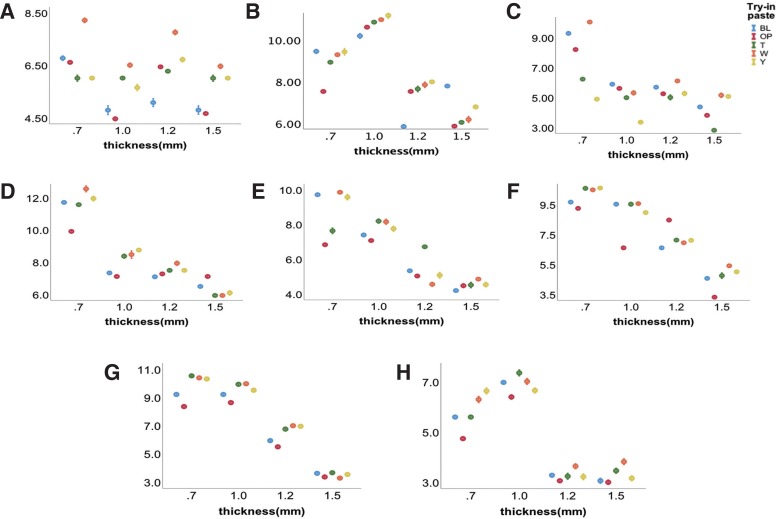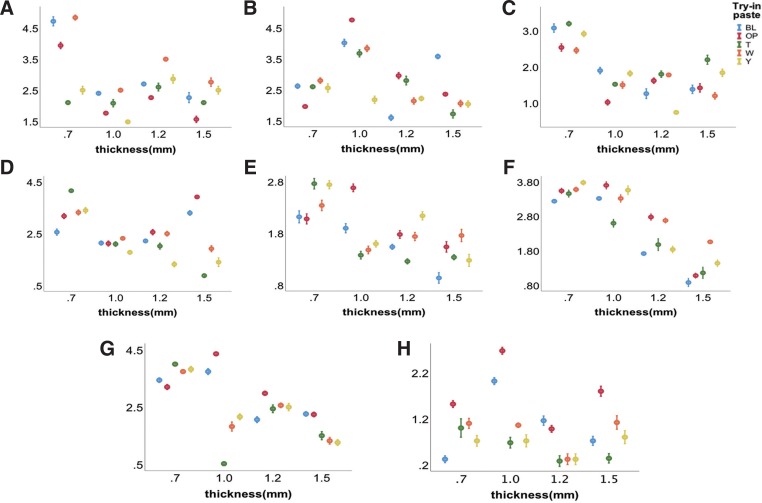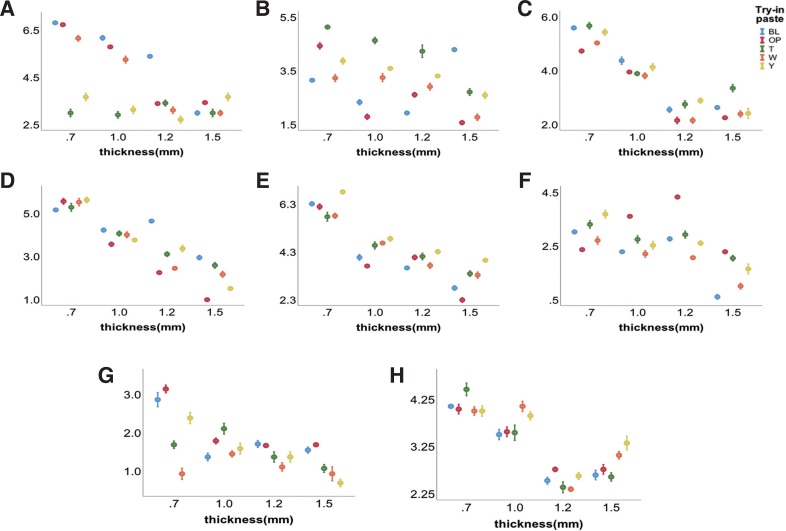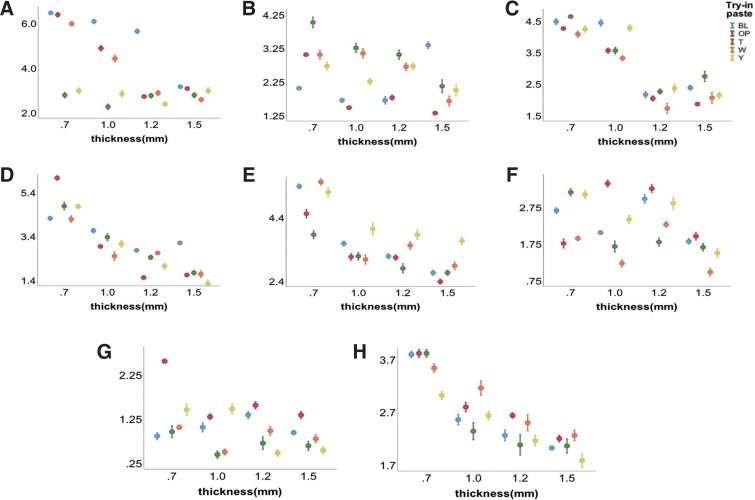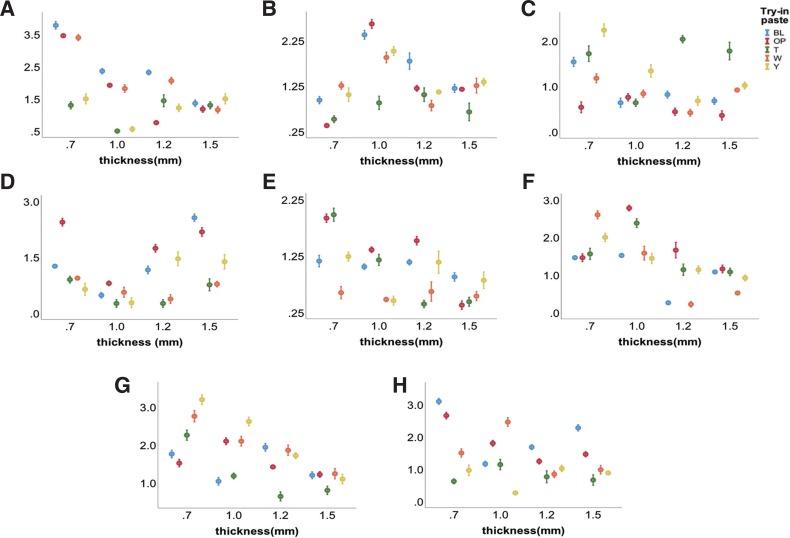J Adv Prosthodont.
2019 Oct;11(5):286-296. 10.4047/jap.2019.11.5.286.
Choice of resin cement shades for a high-translucency zirconia product to mask dark, discolored or metal substrates
- Affiliations
-
- 1Jiangsu Key Laboratory of Oral Diseases; Department of Prosthodontics, Affiliated Hospital of Stomatology, Nanjing Medical University, Nanjing, China. xhf-1980@126.com
- 2Jiangsu Key Laboratory of Oral Diseases; Department of Endodontics, Affiliated Hospital of Stomatology, Nanjing Medical University, Nanjing, China.
- KMID: 2462112
- DOI: http://doi.org/10.4047/jap.2019.11.5.286
Abstract
- PURPOSE
The aim was to study the masking ability of high-translucency monolithic zirconia and provide guidance in selecting resin luting cements in order to mask discolored substrates.
MATERIALS AND METHODS
160 high-translucency zirconia specimens were divided into 32 groups depending on their thickness and shades. Using five shades of try-in paste, the specimens were luted onto the sub strates (Co-Cr, precious-metal, opaque porcelain-sintered Co-Cr, opaque porcelain-sintered precious-metal, and 5M3-shade zirconia). All CIELAB color parameters were measured and statistically analyzed.
RESULTS
Zirconia shade and thickness and try-in paste shade affected CIELAB color parameters (P=.000) in different substrates groups, and there were interactions among these factors (P=.000). All five try-in paste shades can be chosen to achieve ΔE values of zirconia with 1.2 - 1.5 mm for masking dark-tooth-like 5M3-shade and zirconia with 1.5 mm for masking precious-metal groups < 2.6. Only suitable try-in paste shades were used, can ΔE values that less than 2.6 be achieved when applied translucent monolithic zirconia with 0.7-1.0 mm for masking dark-tooth-like 5M3-shade and zirconia with 0.7 - 1.2 mm for masking precious-metal groups.
CONCLUSION
Choosing suitable resin cement shades is necessary for high-translucency monolithic zirconia to achieve ideal masking ability (ΔE < 2.6) on the dark-tooth.
Keyword
Figure
Reference
-
1. Tabatabaian F, Bakhshaei D, Namdari M. Effect of Resin Cement Brand on the Color of Zirconia-Based Restorations. J Prosthodont. 2018; 7. 20.
Article2. Miyazaki T, Nakamura T, Matsumura H, Ban S, Kobayashi T. Current status of zirconia restoration. J Prosthodont Res. 2013; 57:236–261. PMID: 24140561.
Article3. Lee YK. Translucency of dental ceramic, post and bracket. Materials (Basel). 2015; 8:7241–7249. PMID: 28793634.
Article4. Salas M, Lucena C, Herrera LJ, Yebra A, Della Bona A, Pérez MM. Translucency thresholds for dental materials. Dent Mater. 2018; 34:1168–1174. PMID: 29764698.
Article5. Baldissara P, Wandscher VF, Marchionatti AME, Parisi C, Monaco C, Ciocca L. Translucency of IPS e.max and cubic zirconia monolithic crowns. J Prosthet Dent. 2018; 120:269–275. PMID: 29475752.
Article6. Stefanescu C, Ionita C, Nechita V, Drafta S, Oancea L, Petre A. Survival rates and complications for zirconia-based fixed dental prostheses in a period up to 10 years: A systematic review. Eur J Prosthodont Restor Dent. 2018; 26:54–61. PMID: 29517875.7. Silva LHD, Lima E, Miranda RBP, Favero SS, Lohbauer U, Cesar PF. Dental ceramics: a review of new materials and processing methods. Braz Oral Res. 2017; 31:e58. PMID: 28902238.
Article8. Aktas G, Sahin E, Vallittu P, Ozcan M, Lassila L. Effect of colouring green stage zirconia on the adhesion of veneering ceramics with different thermal expansion coefficients. Int J Oral Sci. 2013; 5:236–241. PMID: 24158142.
Article9. Ghodsi S, Jafarian Z. A review on translucent zirconia. Eur J Prosthodont Restor Dent. 2018; 26:62–74. PMID: 29797847.10. Matsuzaki F, Sekine H, Honma S, Takanashi T, Furuya K, Yajima Y, Yoshinari M. Translucency and flexural strength of monolithic translucent zirconia and porcelain-layered zirconia. Dent Mater J. 2015; 34:910–917. PMID: 26632242.
Article11. Al Hamad KQ, Obaidat II, Baba NZ. The effect of ceramic type and background color on shade reproducibility of all-ceramic restorations. J Prosthodont. 2018; 12. 07.
Article12. Tabatabaian F, Masoomi F, Namdari M, Mahshid M. Effect of three different core materials on masking ability of a zirconia ceramic. J Dent (Tehran). 2016; 13:340–348. PMID: 28127328.13. Giti R, Hojati SA. Effect of varying thickness and number of coloring liquid applications on the color of anatomic contour monolithic zirconia ceramics. J Dent (Shiraz). 2018; 19:311–319. PMID: 30680305.14. Tabatabaian F, Shabani S, Namdari M, Sadeghpour K. Masking ability of a zirconia ceramic on composite resin substrate shades. Dent Res J (Isfahan). 2017; 14:389–394. PMID: 29238377.
Article15. Sakai T, Sato T, Hisanaga R, Shinya A, Takemoto S, Yoshinari M. Optical properties and flexural strength of translucent zirconia layered with high-translucent zirconia. Dent Mater J. 2019; 38:368–377. PMID: 30814456.
Article16. Suputtamongkol K, Tulapornchai C, Mamani J, Kamchatphai W, Thongpun N. Effect of the shades of background substructures on the overall color of zirconia-based all-ceramic crowns. J Adv Prosthodont. 2013; 5:319–325. PMID: 24049574.
Article17. Vichi A, Ferrari M, Davidson CL. Influence of ceramic and cement thickness on the masking of various types of opaque posts. J Prosthet Dent. 2000; 83:412–417. PMID: 10756290.
Article18. Brewer JD, Akers CK, Garlapo DA, Sorensen SE. Spectrometric analysis of the influence of metal substrates on the color of metal-ceramic restorations. J Dent Res. 1985; 64:74–77. PMID: 3855423.
Article19. Church TD, Jessup JP, Guillory VL, Vandewalle KS. Translucency and strength of high-translucency monolithic zirconium oxide materials. Gen Dent. 2017; 65:48–52.20. Wang F, Takahashi H, Iwasaki N. Translucency of dental ceramics with different thicknesses. J Prosthet Dent. 2013; 110:14–20. PMID: 23849609.
Article21. Bacchi A, Boccardi S, Alessandretti R, Pereira GKR. Substrate masking ability of bilayer and monolithic ceramics used for complete crowns and the effect of association with an opaque resin-based luting agent. J Prosthodont Res. 2019; 63:321–326. PMID: 30755361.
Article22. Piwowarczyk A, Lauer HC, Sorensen JA. The shear bond strength between luting cements and zirconia ceramics after two pre-treatments. Oper Dent. 2005; 30:382–388. PMID: 15986960.23. Dede DÖ, Sahin O, Özdemir OS, Yilmaz B, Celik E, Köroğlu A. Influence of the color of composite resin foundation and luting cement on the final color of lithium disilicate ceramic systems. J Prosthet Dent. 2017; 117:138–143. PMID: 27622787.
Article24. Pires LA, Novais PM, Araújo VD, Pegoraro LF. Effects of the type and thickness of ceramic, substrate, and cement on the optical color of a lithium disilicate ceramic. J Prosthet Dent. 2017; 117:144–149. PMID: 27460330.
Article25. Xing W, Chen X, Ren D, Zhan K, Wang Y. The effect of ceramic thickness and resin cement shades on the color matching of ceramic veneers in discolored teeth. Odontology. 2017; 105:460–466. PMID: 28074386.
Article26. Dede DÖ, Ceylan G, Yilmaz B. Effect of brand and shade of resin cements on the final color of lithium disilicate ceramic. J Prosthet Dent. 2017; 117:539–544. PMID: 27765394.
Article27. Sproull RC. Color matching in dentistry. II. Practical applicationsof the organization of color. J Prosthet Dent. 1973; 29:556–566. PMID: 4513307.28. Tabatabaian F. Color in zirconia-based restorations and related factors: A literature review. J Prosthodont. 2018; 27:201–211. PMID: 29315947.
Article29. Ragain JC Jr, Johnston WM. Color acceptance of direct dental restorative materials by human observers. Color Res Appl. 2000; 25:278–285.
Article30. Douglas RD, Steinhauer TJ, Wee AG. Intraoral determination of the tolerance of dentists for perceptibility and acceptability of shade mismatch. J Prosthet Dent. 2007; 97:200–208. PMID: 17499089.
Article31. Ruyter IE, Nilner K, Moller B. Color stability of dental composite resin materials for crown and bridge veneers. Dent Mater. 1987; 3:246–251. PMID: 3479360.
Article32. Sinmazisik G, Demirbas B, Tarcin B. Influence of dentin and core porcelain thickness on the color of fully sintered zirconia ceramic restorations. J Prosthet Dent. 2014; 111:142–149. PMID: 24189117.
Article33. Kim HK, Kim SH, Lee JB, Han JS, Yeo IS, Ha SR. Effect of the amount of thickness reduction on color and translucency of dental monolithic zirconia ceramics. J Adv Prosthodont. 2016; 8:37–42. PMID: 26949486.
Article34. Ilie N, Stawarczyk B. Quantification of the amount of light passing through zirconia: the effect of material shade, thickness, and curing conditions. J Dent. 2014; 42:684–690. PMID: 24657553.
Article
- Full Text Links
- Actions
-
Cited
- CITED
-
- Close
- Share
- Similar articles
-
- Translucency and masking ability of translucent zirconia; comparison with conventional zirconia and lithium disilicate
- Effect of resin cement color on the color of commercially available zirconia crown
- Influences of luting cement shade on the color of various translucent monolithic zirconia and lithium disilicate ceramics for veneer restorations
- Microhardness of resin cements after light activation through various translucencies of monolithic zirconia
- Colorimetric Analysis of Preformed Zirconia Anterior Crowns for Esthetic Restoration

